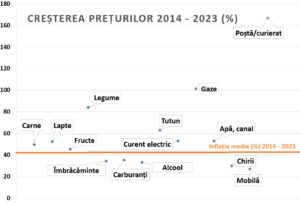 The Ministry of Health has launched to public debate a government decision draft to amend the calculation methodology and the endorsement/approval procedure for the maximal prices of medicines.
The Ministry of Health has launched to public debate a government decision draft to amend the calculation methodology and the endorsement/approval procedure for the maximal prices of medicines.
The draft decision relaunches, on the one hand, the issue of predictability in business: it is issued in less than 3 months after similar changes have been approved by the previous government, based on which the industry has already made its plans for 2017.
On the other hand, according to the industry calculations based on the present version of the draft decision, the impact of price cuts will force nearly 40% of pharmacies to function with zero profit, while 28% of them would be exposed to the risk of defaulting.
Amendments proposed by the new Minister of Health
The draft decision of the Ministry of Health preserves, as stated in explanatory memorandum, „most of the matters covered by Decision 800/2016 of 26 October 2016 (amended in November 2016), but changes some essential aspects:
- Proposes to limit the price of the innovative medicines for which there is at least one generic medicine available in Romania, to the smallest price from the countries used as benchmark or 65% of the price of the innovative medicine, for the first generic medicine
- Waives the three-stage process for bringing the price of the innovative medicine to the maximum level of the generic/biosimilar reference price and introduces the one-step process, starting with the correction to take place in 2017.
According to the explanatory memorandum, the methodology for calculating the maximal price of medicines changes because the regulations in force „would increase the price (…) and therefore limit public access to relevant treatments. In this regard, the former procedure for increasing the maximal prices of medicines is repealed.
The Ministry of Health also communicates to the producers of innovative medicines which invest significant amounts in research that, in his opinion, since the expiration of patent and market entry of the generic/biosimilar medicines, the same pricing approach should be applied to the innovative medicines as to the generics.
„After the patent expires, a real competition should exist between the innovative and generic/biosimilar medicines, including on their prices; that will be ensured by applying the same calculation method for innovative off-patent medicines as for the generic/biosimilar medicines,” is the wish of the ministry.
The draft decision also provides for the introduction of a Public national catalogue of prices – to comprise the maximal prices of medicines used/sold by healthcare or medicines providers which are not under a contract with the Ministry of Health, national health insurance houses and/or health departments.
According to the explanatory memorandum, the decision to decrease the price of some medicines has no financial impact on the budget, either in the short and long term, as all changes are to be borne by the producer-distributor-retailer chain.
Effects announced by the industry: Government decision would disturb over 48% of the market
The deadline for implementing the future decision is apparently generous: no more than 150 days since the deadline for entry into force of the decision.
The problem is that pharmacies are generally functioning with stocks of medicines covering 2 months and after the entry into force of the decision, the price change (significant, 35%) should be borne by the companies.
In short: if a medicine gets in the stock at a price of 100 lei, for instance, the pharmacy is required to sell it for 65 lei. The economic but inhumane alternative would be that, during the 150 days until the entry into force of the new regulations, the pharmacies to get rid of the stocks (namely, to stop supplying), but such a decision would cause at some point a lack of certain medicines on the market.
According to the latest official statistics available, in Romania, on 31 December 2015, there were 3,445 companies active in the sale of medicines, with 6,365 work sites.
From the industry data, the price cut impact on the profit rate of pharmacies represents 1.33% of their turnover.
Although a small percentage at first glance, it should be seen in the context: from the accounting data provided by the industry, 1,351 companies owning 2,480 work sites, have a maximum profit rate of 1.3% of the turnover. That would mean that 39% of the industry would lose its economic reason of being.
Taking into account the averages stocks for one month, the pharma industry has also calculated the risk of defaulting, based on the accounting details to date: it is about 961 companies with 1,798 work sites, namely 28% of the industry.
There are also companies in both situations: decrease of profit rate and significant impact on stocks. Summary in the table below:
*
- Total number of pharmacies at 31 December 2015 – 6,365 work sites
- Pharmacies with profit rate <= 1.3%
- Pharmacies that could not pay due amounts to suppliers
- In both situations above
- Total number of pharmacies affected by the price cut
*
The conclusion that the industry points out: One single governmental decision puts 48% of the market at risk.










